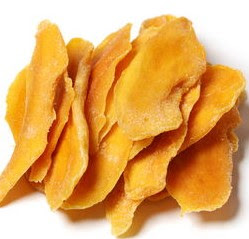One way to tackle post-harvest losses is drying. The shelf life of dried products is almost unlimited and the cost of transportation, handling and storage are considerably lower than that of other methods of preservation.
Mango has a high perishability and a seasonal availability, so, in a dried form, its availability over a longer period of time increases, which potentially contributes to increased fruit consumption. Dried mango products (slices or flakes) are generally prepared from ripe mangoes and dehydrated using a variety of methods including solar, hot-air cabinet, vacuum, spray, or freeze dryers.
Postharvest losses of mango fruit in a number of developing countries in Africa and Asia have been estimated to be as high as over 50%, especially during the main harvest season. Drying mangoes is an ideal value-added opportunity for processors in many developing countries, as processing requirements are relatively non-capital intensive.
These dried fruit pieces retain some softness, and the drying process generally provides fairly uniform preservation.
Dried mango slices or pieces, most often sold under the organic label, generally produced using a more or less artisanal processing technique. These products have an often-heterogeneous quality in terms of shape and coloration, as well as a limited shelf life.
Dried mango is a ready to eat healthy snack for all age groups. Dried mango also tastes delicious when it is soaked in water, juices and yogurt.
There are three main types that can be distinguished:
*Sweetened dried mangoes
*Conventional dried mangoes
*Natural dried mangoes
Dried mangoes
Mango is one of the popular fruits in the world due to its attractive color, delicious taste and excellent nutritional properties. Known for its sweet fragrance and flavor, the mango has delighted the senses for more than 4000 years. A celebrated fruit, mango, now produced in most of the tropical parts of the globe.
Wednesday, December 22, 2021
Popular Posts
-
History and Origin of Mango The mango has been known in India since very early times. It is referred to in Sanskrit literature as Amra and h...
-
This tropical fruit is high in vitamin C. Mango fruits contain 10-20 percent sugar and are important source of vitamin A. They have a rich,...
-
Uses of Mango and Nutritional Composition Mango is commonly eaten fresh and depending upon the cultivar may be consumed at an immature (unri...
-
The mango is believed to have been discovered as long as five to six thousand years in eastern India, Thailand, Myanmar, the Andaman Islands...





